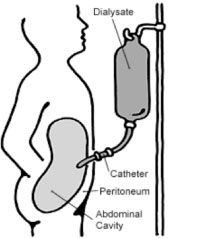The Peritoneal Equilibration Test for Peritoneal Dialysis
 How do you know which type of peritoneal dialysis (PD) is best suited to your body? A PET can tell you. Done at the end of training (or end of your first month of PD), the PET can suggest how long PD fluid should stay (dwell) in your belly for the best results.
How do you know which type of peritoneal dialysis (PD) is best suited to your body? A PET can tell you. Done at the end of training (or end of your first month of PD), the PET can suggest how long PD fluid should stay (dwell) in your belly for the best results.
Meet your peritoneum
With PD, your peritoneum—a blood-vessel rich tissue cover that lines the inside of your abdomen and outside of your organs—helps clean your blood. You use a catheter (plastic tube) to fill your belly with sterile PD fluid (dialysate). Tiny capillary blood vessels in your peritoneum act as filters. Wastes and extra water flow from your blood into the dialysate, which you then drain out. You can exchange used fluid for fresh by hand or with a cycler machine.
In the second figure, your peritoneum is shown in yellow. On the left is your bloodstream—blood cells and some proteins are too large to pass through the pores (holes) in your peritoneum. On the right, PD fluid is blue, with wastes and water flowing into it.
 Until you use your peritoneum for PD, there is no way to tell how well it will "transport" wastes and water out of your blood. Your body is unique. You may have a large, medium, or small number of pores. A large number of pores means your peritoneum is quite
permeable
(porous). It will let wastes pass through quickly—but you might also absorb a lot of dextrose (sugar) from the PD fluid. A small number of pores mean that cleaning your blood can take longer—or sometimes that PD won't be able to work for you and perhaps home hemodialysis would be a better choice.
Until you use your peritoneum for PD, there is no way to tell how well it will "transport" wastes and water out of your blood. Your body is unique. You may have a large, medium, or small number of pores. A large number of pores means your peritoneum is quite
permeable
(porous). It will let wastes pass through quickly—but you might also absorb a lot of dextrose (sugar) from the PD fluid. A small number of pores mean that cleaning your blood can take longer—or sometimes that PD won't be able to work for you and perhaps home hemodialysis would be a better choice.
How a PET is done 1
A PET measures how well your peritoneum transports wastes and water. To do the test, you'll come into the clinic in the morning. Plan to be there for 4 hours or more. (NOTE: This section describes the standardized test that is described in the medical literature. Your clinic may do a PET differently.)
 First, you'll drain out last night's PD fluid. Then, you'll lie down and fill with two liters of 2.5% dextrose fluid at 200 mL/min for 10 minutes. Every two minutes, you'll roll from side to side to be sure the fluid is well mixed in your abdomen. As soon as all of the fluid is in, you'll drain out 200 mL, and a 10 mL sample will be taken out. The rest will be put back into your belly.
First, you'll drain out last night's PD fluid. Then, you'll lie down and fill with two liters of 2.5% dextrose fluid at 200 mL/min for 10 minutes. Every two minutes, you'll roll from side to side to be sure the fluid is well mixed in your abdomen. As soon as all of the fluid is in, you'll drain out 200 mL, and a 10 mL sample will be taken out. The rest will be put back into your belly.
Once this step is done, you'll walk or move around for 2 hours while the fluid dwells. Then, a second sample of drain fluid will be taken, and a blood sample will be drawn. After 2 more hours of dwell time, you'll sit or stand to drain completely. This usually takes 20 minutes. The drain volume will be checked and another sample of the drain fluid will be taken. Each of the drain fluid samples and your blood will be tested to see how much glucose and creatinine (a waste removed by dialysis) are present.
What PET results mean to you
A PET will show if your peritoneum has a high, average, or low transport rate. The test looks at your drain volume, how much dextrose is left in the fluid sample, and how much creatinine is in your drain fluid vs. your blood.
The table below, adapted from the UK National Kidney Foundation2, helps explain what each level means in terms of the type of PD that is best suited for you:
| Level | Waste removal | Water removal | Your best PD match |
|---|---|---|---|
| High | Fast | Poor | APD - Short dwells and frequent exchanges |
| Average | Okay | Okay | APD, CAPD |
| Low | Slow | Good | CAPD |
As you can see, if you are a high transporter, your best match is a cycler (automated PD, or APD). Short, fast exchanges will help keep you from absorbing too much PD fluid or dextrose.
If you are a low transporter, it's best if you do exchanges by hand (CAPD) and space them out well so you have lots of dwell time to remove wastes.
If you are an average transporter, you can choose which type of PD you'd prefer—either type should work for you.
The best PD for you
In the U.S., cycler PD is the most used type, but what is most important is what fits your life—and your body. In most cases, you will have a choice about what type of PD you can do. The PET can help inform your choice so your PD will work as well as possible.
References:
- Twardowski ZJ. Clinical value of standardized equilibration tests in CAPD patients. Blood Purif. 1989;7:95-108.
- What is a Peritoneal Equilibration Test?; accessed January 2008.

